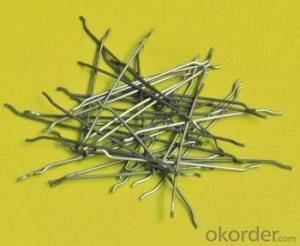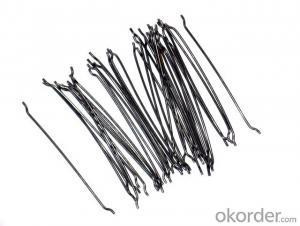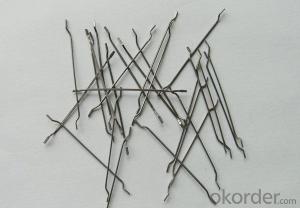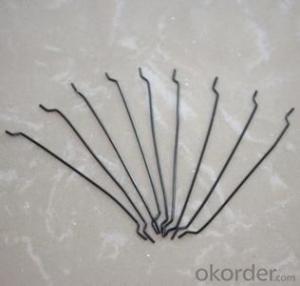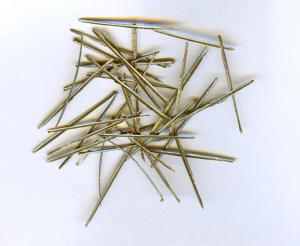Melt Extract Stainless Steel Fiber Cement Price Constructions Steel Fiber CNBM
- Loading Port:
- Tianjin
- Payment Terms:
- TT OR LC
- Min Order Qty:
- 1 m.t.
- Supply Capability:
- 600 m.t./month
OKorder Service Pledge
Quality Product, Order Online Tracking, Timely Delivery
OKorder Financial Service
Credit Rating, Credit Services, Credit Purchasing
You Might Also Like
Quick Details
Place of Origin: Tianjin, China (Mainland)
- Model Number: 0.55
Material: Steel
Production Process: Cold drawn
Fiber Lengh: 35
Type: 1
Compressive Strength: >1200MPa
Aspect ratio: 63
Standard: ASTM A820M-11
Section Shape: Circular
Application: Concrete Reinforcement
- Product Application: Industrial Floor
Packaging & Delivery
| Packaging Details: | 20 kg/Bag,50 bags/Pallet or 1,000kg/ Bulk Bag |
|---|---|
| Delivery Detail: | 1 Month |
Product Description
| Diameter | 0.55 | mm | 0.02 | in |
| Length | 35.00 | mm | 1.37 | in |
| Aspect Ratio | 64 | |||
| Tensile strength | 1200 MPa | |||
| Type | Cold drawn Steel Fiber | |||
| End | Hooked-end Steel Fiber | |||
| Glued/Loose | Glued Steel Fiber | |||
| Bending Angle | 45°(min.30°) | |||
| Usage & Performance | Floor:Trafficked areas and Industrial floors | |||
| Shotcrete :Slope stabilization and Final lining | ||||
| Precast concrete:Pipe and Railway sleepers | ||||
| Packing | Standard Export Pallet Packing | Bag Packing | 20 kg/Bag,50 bags/Pallet | |
| Bulk Packing | 1,000kg/ Bulk Bag | |||
| Loading Quantity | 20’GP | 20-25 Tonne/Tonnes | ||
| 40’GP | 25-27 Tonne/Tonnes | |||
| 40’HQ | 25-27 Tonne/Tonnes | |||
| MOQ | 1 kg for trial order | |||
| Supply Ability | 10,000 Tonne/Tonnes per Year | |||
| Payment Terms | T/T or L/C at sight | |||
| Delivery Time | Within 15 days after receiving deposit or original L/C at sight | |||
| Certification | ISO9001:2000, CE, | |||
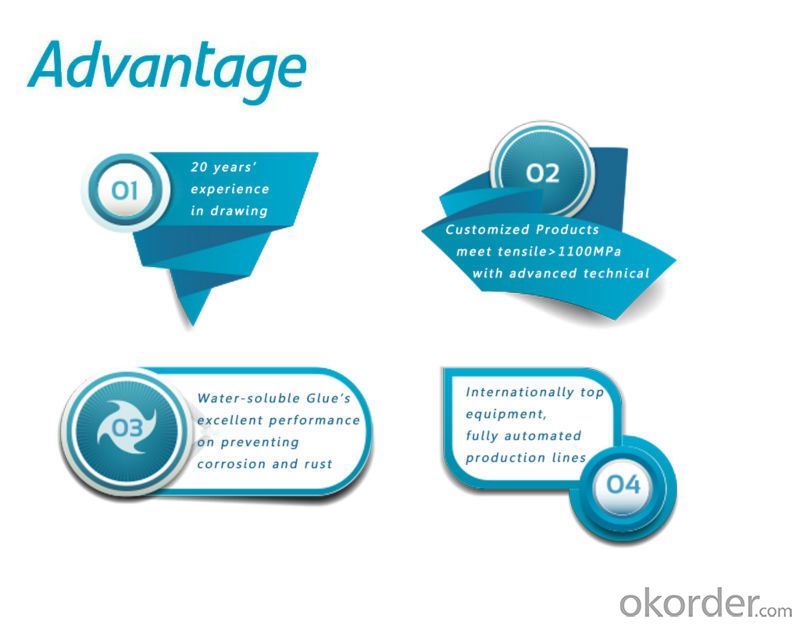
| Product | Diameter | Length mm/in | Aspect Ratio | Type | Packing |
| G-6030 | 0.5 mm (0.0197 in) | 30 mm (1.1811 in) | 60 | Glued | 20 kg/Bag, or 1,000kg/ Bulk Bag |
| G-6535 | 0.55 mm (0.0217 in) | 35 mm (1.3780 in) | 65 | Glued | 20 kg/Bag, or 1,000kg/ Bulk Bag |
| G-6035 | 0.6 mm (0.0236 in) | 35 mm (1.3780 in) | 60 | Glued | 20 kg/Bag, or 1,000kg/ Bulk Bag |
| G-8060 | 0.75 mm (0.0295 in) | 60 mm (2.3622 in) | 80 | Glued | 20 kg/Bag, 50 bags/Pallet |
| G-6060 | 0.9 mm (0.0354 in) | 60 mm (2.3622 in) | 60 | Glued | 20 kg/Bag, 50 bags/Pallet |
| G-6030 | 0.5 mm (0.0197 in) | 30 mm (1.1811 in) | 60 | Loose | 20 kg/Bag, or 1,000kg/ Bulk Bag |
| G-6535 | 0.55 mm (0.0217 in) | 35 mm (1.3780 in) | 65 | Loose | 20 kg/Bag, or 1,000kg/ Bulk Bag |
| G-6035 | 0.6 mm (0.0236 in) | 35 mm (1.3780 in) | 60 | Loose | 20 kg/Bag, or 1,000kg/ Bulk Bag |
| G-8060 | 0.75 mm (0.0295 in) | 60 mm (2.3622 in) | 80 | Loose | 20 kg/Bag, 50 bags/Pallet |
| G-6060 | 0.9 mm (0.0354 in) | 60 mm (2.3622 in) | 60 | Loose | 20 kg/Bag, 50 bags/Pallet |
- Q: How does melt extract stainless steel fiber affect the permeability of concrete to water?
- The permeability of concrete to water can be significantly influenced by the use of melt extract stainless steel fiber. To enhance the durability and overall performance of the structure, stainless steel fibers are introduced into concrete mixtures. By incorporating stainless steel fibers into concrete, a three-dimensional network of reinforcement is formed within the matrix. This network acts as a barrier, limiting the flow of water through the concrete. The fibers create a complex pathway for water molecules, thereby reducing the material's permeability. Furthermore, the presence of stainless steel fibers plays a role in reducing the occurrence of microcracks in concrete. Microcracks can arise from various factors such as shrinkage, temperature fluctuations, and external forces. These cracks create openings for water to infiltrate the concrete, thereby increasing its permeability. However, the inclusion of stainless steel fibers helps manage and minimize the development and propagation of these cracks, subsequently decreasing the concrete's permeability. Additionally, stainless steel fibers bring added advantages to the concrete matrix by enhancing its tensile strength and ductility. This increased strength allows the concrete to better endure external loads and pressures, thus diminishing the likelihood of crack formation and water seepage. To summarize, the introduction of melt extract stainless steel fiber into concrete has a positive impact on its permeability to water. The fibers establish a barrier that restricts the movement of water molecules and assist in controlling the formation of microcracks, ultimately reducing the concrete's permeability.
- Q: Can melt extract stainless steel fiber be used in the construction of cooling towers?
- Yes, melt extract stainless steel fiber can be used in the construction of cooling towers. Cooling towers are typically exposed to harsh environments, including high temperatures and corrosive chemicals. Stainless steel fibers have excellent resistance to corrosion and high temperatures, making them suitable for such applications. These fibers can be used to reinforce the concrete used in the construction of cooling towers, enhancing their mechanical properties and durability. Additionally, stainless steel fibers can improve the crack resistance and prevent the propagation of cracks in the concrete, ensuring the structural integrity of the cooling tower. Overall, using melt extract stainless steel fiber in the construction of cooling towers can enhance their performance, longevity, and resistance to corrosion and high temperatures.
- Q: Is melt extract stainless steel fiber corrosion resistant?
- Indeed, melt extract stainless steel fiber exhibits remarkable resistance to corrosion. The presence of chromium in its composition grants stainless steel with exceptional corrosion resistance. Chromium enables the formation of a fine, protective oxide layer on the steel's surface, effectively thwarting corrosion and the development of rust. Consequently, melt extract stainless steel fiber is exceptionally well-suited for deployment in demanding environments or situations involving exposure to corrosive agents. Moreover, the fiber's corrosion resistance guarantees its longevity and durability across diverse sectors like construction, automotive, and aerospace.
- Q: Can melt extract stainless steel fiber be used in the construction of railway tunnels?
- Yes, melt extract stainless steel fiber can be used in the construction of railway tunnels. Stainless steel fiber is known for its high strength, durability, and resistance to corrosion, which makes it suitable for various construction applications, including railway tunnels. The use of stainless steel fiber in tunnel construction helps to enhance the overall structural integrity and longevity of the tunnels. It can reinforce the concrete used in the tunnel lining, providing increased resistance to cracking and improved load-bearing capacity. Additionally, stainless steel fibers can also offer enhanced fire resistance properties, which is crucial for ensuring the safety of railway tunnels. Therefore, melt extract stainless steel fiber is a suitable material to be used in the construction of railway tunnels.
- Q: What is the effect of melt extract stainless steel fiber on the autogenous shrinkage of concrete?
- Concrete experiences a reduction in autogenous shrinkage when the melt extract stainless steel fiber is utilized. Autogenous shrinkage refers to the natural self-drying and subsequent volume decrease of concrete caused by the hydration process. Incorporating stainless steel fibers into the concrete generates a three-dimensional reinforcement network within the matrix. This network strengthens the tensile strength and ductility of the entire concrete. Furthermore, the stainless steel fibers serve as micro-reinforcements, preventing the creation and propagation of cracks during the early stages of concrete hydration. By minimizing crack formation, the stainless steel fibers decrease the likelihood of moisture loss from the concrete. Consequently, this reduces autogenous shrinkage. Acting as a barrier, the stainless steel fibers impede water evaporation from the concrete, maintaining higher moisture levels in the matrix. Additionally, the melt extract stainless steel fibers possess a higher aspect ratio and superior dispersion in comparison to other fiber types like polypropylene or carbon fibers. This improved dispersion guarantees a more even distribution of the fibers throughout the concrete, further enhancing their effectiveness in decreasing autogenous shrinkage. Ultimately, the inclusion of melt extract stainless steel fibers in concrete significantly diminishes autogenous shrinkage by preventing crack formation and minimizing moisture loss. This leads to a more durable and crack-resistant concrete structure.
- Q: What is the recommended mix design when using melt extract stainless steel fiber in concrete?
- The recommended mix design when using melt extract stainless steel fiber in concrete typically involves a dosage rate of 1 to 2% by volume of concrete. This dosage rate helps to enhance the mechanical properties of the concrete, such as its tensile strength, flexural strength, and impact resistance. Additionally, it is important to use a well-graded aggregate and a water-cement ratio that is suitable for the specific application and desired performance requirements.
- Q: How does melt extract stainless steel fiber affect the permeability of concrete?
- Melt extract stainless steel fibers have a significant impact on the permeability of concrete. These fibers are thin, elongated strands that are added to concrete mixtures during the mixing process. When properly dispersed throughout the concrete, they create a three-dimensional network that enhances the overall durability and performance of the concrete. One of the main benefits of adding stainless steel fibers is the reduction in concrete permeability. Concrete is naturally a porous material, allowing liquid and gas to pass through it. However, the addition of stainless steel fibers helps to close these pores and reduce the permeability of the concrete. The melt extract stainless steel fibers act as a physical barrier, preventing the passage of water, chemicals, and other harmful substances into the concrete. This is particularly important in environments where the concrete is exposed to harsh conditions, such as marine or industrial applications. By reducing the permeability of concrete, the addition of stainless steel fibers also improves its resistance to corrosion and deterioration. This is because the fibers help to limit the ingress of moisture and aggressive agents that can cause the reinforcement steel within the concrete to corrode. As a result, the lifespan of the concrete structure is extended, and maintenance costs are minimized. Furthermore, the reduced permeability of concrete with stainless steel fibers also enhances its resistance to freeze-thaw cycles. When water enters the concrete and freezes, it expands, causing internal pressure and leading to cracking and deterioration. The presence of stainless steel fibers helps to restrict the entry of water, thereby reducing the potential for freeze-thaw damage. In summary, melt extract stainless steel fibers have a positive impact on the permeability of concrete. They reduce the passage of water and other harmful substances, enhancing the durability, resistance to corrosion, and resistance to freeze-thaw cycles of the concrete. By improving these properties, stainless steel fibers contribute to the overall performance and longevity of concrete structures.
- Q: Is melt extract stainless steel fiber suitable for use in industrial flooring?
- Yes, melt extract stainless steel fiber is suitable for use in industrial flooring. This type of fiber is specifically designed for applications that require high strength and durability, making it ideal for industrial environments. It can withstand heavy loads, impact, and abrasion, ensuring long-lasting performance in areas with high foot and vehicle traffic. Additionally, stainless steel fibers are resistant to corrosion, which is important in industrial settings where exposure to chemicals or moisture is common. The melt extract process creates fibers with uniform distribution and excellent bonding properties, ensuring optimal reinforcement throughout the flooring material. Overall, melt extract stainless steel fiber is a reliable choice for industrial flooring due to its strength, durability, and resistance to corrosion.
- Q: How does melt extract stainless steel fiber improve the abrasion resistance of concrete?
- Melt extract stainless steel fiber improves the abrasion resistance of concrete by reinforcing the matrix and enhancing its durability. The addition of stainless steel fibers creates a three-dimensional network within the concrete, which helps to distribute the applied load and reduce cracking. This network also acts as a barrier against abrasive forces, preventing the concrete from wearing out quickly. Overall, the incorporation of melt extract stainless steel fiber strengthens the concrete and enhances its ability to withstand abrasion, leading to increased longevity and performance.
- Q: Can melt extract stainless steel fiber be used in nuclear power plant applications?
- Yes, melt extract stainless steel fiber can be used in nuclear power plant applications. Its high melting point, corrosion resistance, and mechanical strength make it suitable for various applications in nuclear power plants, such as reinforcement in concrete structures, thermal insulation, and as a reinforcement material in high-temperature applications.
Send your message to us
Melt Extract Stainless Steel Fiber Cement Price Constructions Steel Fiber CNBM
- Loading Port:
- Tianjin
- Payment Terms:
- TT OR LC
- Min Order Qty:
- 1 m.t.
- Supply Capability:
- 600 m.t./month
OKorder Service Pledge
Quality Product, Order Online Tracking, Timely Delivery
OKorder Financial Service
Credit Rating, Credit Services, Credit Purchasing
Similar products
Hot products
Hot Searches
Related keywords







